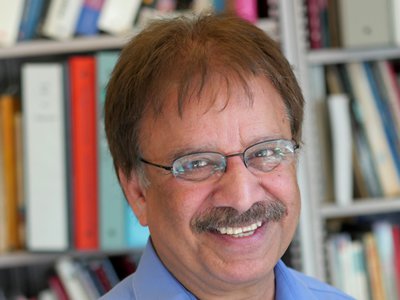Linguist at Home on World Stage
Next stops for Tej Bhatia: Singapore and India

Tej K. Bhatia has traveled the world connecting his expertise in linguistics with a broad array of related topics: trauma, mental health, forensics and tastes.
Bhatia, professor of linguistics in the College of Arts and Sciences and director of South Asian Languages, heads next month to Nanyang Technological University in Singapore as a visiting research professor. Immediately afterwards, he goes to New Delhi, India, to conduct collaborative research on multilingual schizophrenia with a team of psychiatrists at All India Institute of Medical Sciences, one of India’s most prestigious medical schools.
His research in Singapore will touch on social networks in the Indian diaspora there. In addition, Bhatia will give public lectures on forensic linguistics, which uses language to decode a person’s identity. He has previously written about the FBI’s use of forensic linguistics in identifying Ted Kaczynski as the Unabomber, the serial killer involved in a series of crimes between 1978 and 1995.
Bhatia described in Sloan Science & Film, an online publication of the Museum of the Moving Image, how the FBI used Kaczynski’s writings in their investigation. Science & Film commissioned Bhatia to write about the case to coincide with the Discovery Channel’s eight-part series “Manhunt: Unabomber,” released in August.
“With the Unabomber, there were no hair samples, no fingerprints, absolutely no forensic evidence,” he explains. “The investigator used language as a fingerprint.” Forensic linguistics “looks at patterns of language,” he adds. “When people are not carefully editing themselves, they leave clues about themselves. Those are individual fingerprints, which can be used to identity a criminal when there is an absolute poverty of evidence.”
What else is on his plate these days? Popcorn, for one thing. Make that curry-flavored popcorn. He’s studying the language of perception and cognition, particularly the language of taste–focusing on curry flavored popcorn.
“Around the world, curry is used in every possible product,” Bhatia explains. “When it’s used with popcorn, what does that mean to each community? Is it bitter? Is it spicy? Is it sweet? What basic taste descriptions does the word ‘curry’ convey in the global lingua franca, English? In essence, I want to explore the psycholinguistic world of tastes and flavors. What is the semantic mapping of tastes and words? Interestingly, although the word ‘curry’ is pretty universal in the world of cuisines, it means different things in different cultures.”
Bhatia has had a busy year. He is the newly elected president of the International Association for World Englishes (IAWE) and the newest member of the Editorial Advisory Board of IAWE’s journal, World Englishes. The organization is comprised of members from at least 50 countries.
He recently organized and chaired IAWE’s 22nd international conference at Syracuse, attended by more than 200 presenters from 35 countries. The June 30-July 2 conference “showcased our university, research and leadership in this field,” he says.
The term “World Englishes” refers to emerging localized varieties of English, especially forms that have developed in territories influenced by the United Kingdom or the United States.
“English has outgrown its parent varieties (British and American Englishes),” Bhatia says. “New ‘Englishes’ are evolving and innovating across the globe, as a medium of communication and commerce. This is a big part of the future of global communication, international education and global partnerships. As we prepare our students as global professionals, knowledge of world-varieties is not just a laboratory curiosity, but a compelling necessity.”
